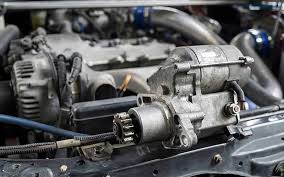WirralCar Repairs
Starter Motor
- Pulley
- Rotor
- Stator
- Voltage Regulator
- Rectifier

Common Issues
- Clicking noise when ignition turned
- YOU’VE GOT LIGHTS BUT NO ACTION
- YOUR ENGINE WON'T CRANK
- SMOKE IS COMING FROM YOUR CAR
- OIL HAS SOAKED THE STARTER

WHAT IS A STARTER MOTOR?
The starter motor is a type of high-torque motor used to start vehicle engines. It’s also called a cranking motor, starting motor, or simply starter. The motor is commonly used in vehicles with internal combustion engines. These engines require an external force to turn them over and start the combustion cycle. The starter motor performs that function perfectly.
The starter motor is one of the parts that make the starting system. Other starter system components include the ignition switch, starter relay, neutral safety switch or clutch switch, flywheel ring gear, and the battery. These parts are connected by wires and other electrical components to make the starting circuits.
HOW DOES A STARTER MOTOR WORK?
It's relatively simple: as you turn the key or press the starter, power is sent to the ignition system to fire the spark plugs, and to a larger magnetic switch, which sends a rush of power direct from the battery to the starter.
That magnetic switch is called the solenoid, and is typically bolted to the starter itself, both switching high amperage power and causing the gears to mesh.
When the electromagnet is engaged, the solenoid plunger connects the thick battery cable to windings within the starter to actually turn the electric motor, plus it pushes a rod, engaging a fork which in turn pushes a pinion gear (connected to the motor) to automatically engage with the flywheel.
WARNING SIGNS OF A BAD STARTER MOTOR
- Clicking noise when ignition turned
- YOU’VE GOT LIGHTS BUT NO ACTION
- YOUR ENGINE WON'T CRANK
- SMOKE IS COMING FROM YOUR CAR
- OIL HAS SOAKED THE STARTER